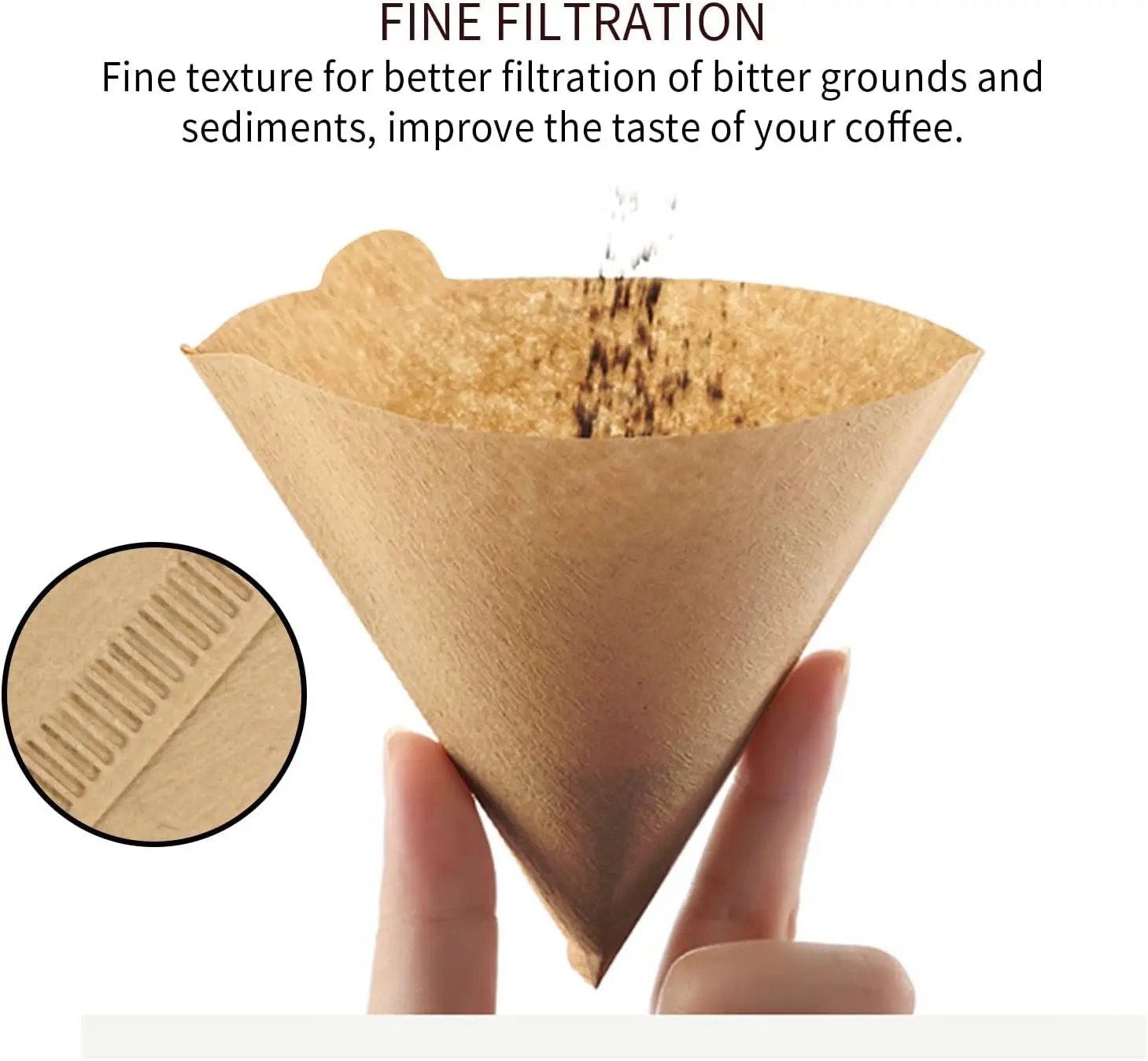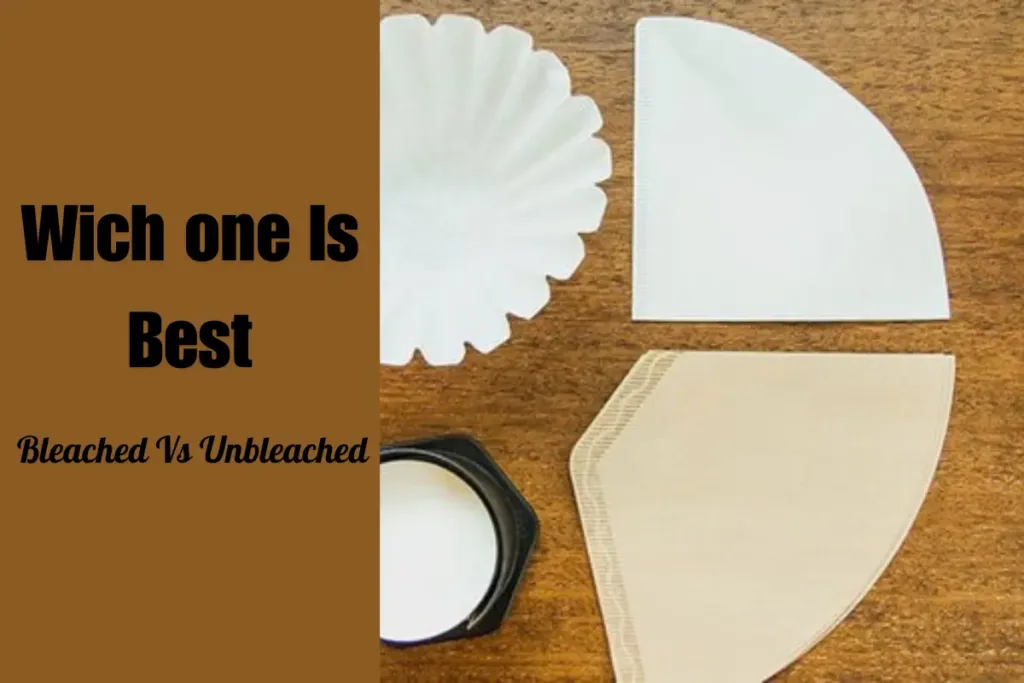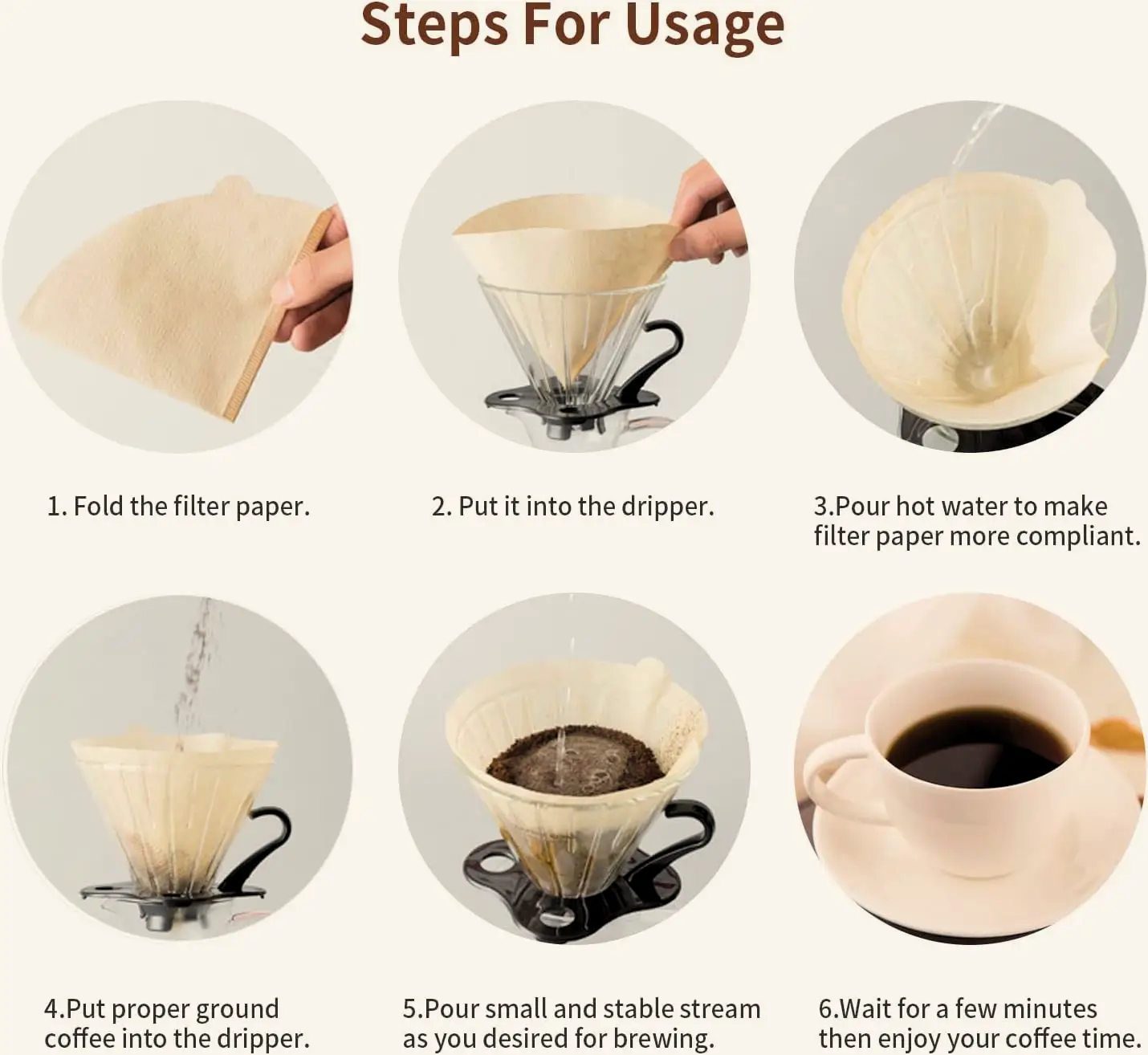Bleached coffee filters are whitened using chemicals, while unbleached filters are naturally brown and chemical-free. Both serve the same brewing purpose.
Coffee enthusiasts often debate the merits of bleached versus unbleached coffee filters. Understanding the differences can help you make an informed choice. Bleached filters go through a whitening process, usually involving chlorine or oxygen. Unbleached filters, on the other hand, retain their natural brown color, avoiding chemical treatments.
Both types effectively filter coffee, but preferences may vary based on environmental impact and taste considerations. Some argue that unbleached filters are more eco-friendly and impart fewer chemical residues, while others prefer the cleaner look of bleached filters. Ultimately, the choice depends on personal preference and environmental concerns.
Bleached Vs Unbleached Coffee Filters
Choosing the right coffee filter can change your coffee experience. The debate between bleached and unbleached coffee filters is ongoing. Each type has its own pros and cons. Understanding these can help you make an informed decision. Let’s dive into the differences between these two types of filters.
The Basic Difference
The main difference between Bleached Vs Unbleached Coffee Filters is their color. Bleached filters are white, while unbleached filters are brown. This color difference comes from the way they are processed.
Manufacturing Processes
Bleached coffee filters undergo a process to make them white. There are two methods for bleaching:
- Chlorine Bleaching: This method uses chlorine to bleach the filters. It is the less eco-friendly option.
- Oxygen Bleaching: This method uses oxygen or ozone. It is considered more environmentally friendly.
Unbleached filters are not treated with bleaching agents. They retain their natural brown color. These filters are often considered more eco-friendly. This is because they undergo fewer chemical processes.
| Aspect | Bleached Filters | Unbleached Filters |
|---|---|---|
| Color | White | Brown |
| Bleaching Method | Chlorine or Oxygen | None |
| Eco-Friendliness | Less Eco-Friendly | More Eco-Friendly |
Choosing between bleached and unbleached filters depends on your preferences. If you are concerned about the environment, unbleached filters might be better. If you prefer a cleaner look, bleached filters could be your choice.
The Importance Of Coffee Filter Choice
Choosing the right coffee filter affects your coffee’s taste and the environment. Understanding the differences between bleached and unbleached filters can help you make an informed choice.
Influence On Flavor
The type of coffee filter you use can change the flavor. Bleached filters are white and have been treated with chemicals. Some people believe this process can affect the taste of coffee. Unbleached filters are brown and more natural. They can leave a slightly papery taste if not rinsed properly. Here is a comparison:
| Filter Type | Flavor Impact |
|---|---|
| Bleached | Possible chemical taste |
| Unbleached | Possible papery taste |
Environmental Impact
Bleached filters involve a chemical process that can harm the environment. The chemicals used can pollute water sources. Unbleached filters are more eco-friendly. They do not use harmful chemicals and are often compostable. Here are some key points:
- Bleached Filters: Chemical process, possible water pollution
- Unbleached Filters: No harmful chemicals, compostable
Choosing unbleached filters helps protect the environment. They are a better choice for eco-conscious coffee drinkers.
Conducting A Taste Test
Conducting a taste test can help you decide between bleached and unbleached coffee filters. The process involves comparing both types to determine which produces the best coffee flavor. This section will guide you through setting up and evaluating your taste test.
Setting Up The Test
First, gather all necessary items:
- Two types of coffee filters: bleached and unbleached
- Your favorite coffee beans
- A coffee grinder
- Two coffee makers
- Water
- Two identical mugs
- A notebook for notes
Grind the same amount of coffee beans for each filter. Use identical coffee makers for brewing. This ensures a fair comparison.
Label the mugs as “Bleached” and “Unbleached” to avoid confusion. Brew the coffee using the same water temperature and brewing time.
Criteria For Evaluation
Evaluate the coffee based on the following criteria:
- Aroma: Smell the coffee and note any differences.
- Flavor: Taste the coffee and focus on the flavors.
- Acidity: Assess the acidity level in each cup.
- Body: Check the mouthfeel and richness.
- Aftertaste: Observe any lingering flavors.
Use a table to record your observations:
| Criteria | Bleached Filter | Unbleached Filter |
|---|---|---|
| Aroma | ||
| Flavor | ||
| Acidity | ||
| Body | ||
| Aftertaste |
Note your preferences and any significant differences between the two types of coffee filters. This will help you decide the best filter for your coffee experience.
Taste Profiles With Bleached Filters
Bleached coffee filters are a popular choice among many coffee enthusiasts. They can subtly affect the taste of your coffee. This section explores the taste profiles you can expect with bleached filters.
Flavor Notes
Bleached filters can influence the flavor of your coffee. They remove some of the oils that contribute to a richer taste. This results in a cleaner and lighter flavor profile.
- Cleaner Taste: Offers a pure coffee flavor.
- Less Bitter: Reduces the bitterness often found in unfiltered coffee.
- Subtle Notes: Enhances delicate flavors.
Aroma And Aftertaste
The aroma from bleached filters can be more refined. This is because they remove some of the stronger-smelling oils.
| Aspect | Bleached Filters |
|---|---|
| Aroma | More subtle and less overpowering. |
| Aftertaste | Cleaner finish with less residue. |
Bleached filters often leave a smoother aftertaste. They make every sip more enjoyable and less harsh.
Taste Profiles With Unbleached Filters
Unbleached coffee filters are increasingly popular among coffee enthusiasts. They are considered more natural and eco-friendly compared to bleached filters. But do they alter the taste of your coffee? Let’s explore the unique taste profiles associated with unbleached filters.
Flavor Notes
Unbleached filters often impart a subtle, earthy flavor. This can complement the natural flavors of the coffee beans. Some drinkers find that unbleached filters add a slight hint of paper taste. This is usually noticeable in the first few sips.
To minimize this, rinse the filter with hot water before brewing. This helps to remove any residual paper taste. The flavors of the coffee then become more pronounced and enjoyable.
Aroma And Aftertaste
The aroma of coffee brewed with unbleached filters can be richer. The natural fibers in the filter allow more of the coffee’s oils to pass through. This enhances the aromatic profile significantly.
The aftertaste is also affected. Many coffee lovers appreciate the fuller, more robust finish that unbleached filters provide. The natural elements of the filter contribute to a lingering, pleasant aftertaste.
| Aspect | Unbleached Filters |
|---|---|
| Flavor | Earthy, slight paper taste |
| Aroma | Rich and robust |
| Aftertaste | Fuller and lingering |
- Natural Feel: Unbleached filters are more eco-friendly.
- Preparation: Rinse before use for better flavor.
- Enhanced Experience: Richer aroma and fuller aftertaste.
Comparative Analysis
Choosing between bleached and unbleached coffee filters can be confusing. Each type has its pros and cons. This comparative analysis will help you decide. We’ll look at expert opinions and consumer preferences. Let’s dive in!
Expert Opinions
Experts often debate the environmental impact of coffee filters. Bleached filters use chemicals like chlorine. These chemicals can harm the environment. Unbleached filters are more eco-friendly. They skip the bleaching process.
Some coffee experts claim unbleached filters affect the taste. The paper’s natural color might add a slight flavor. Bleached filters are more neutral. They don’t change the coffee’s taste.
| Aspect | Bleached Filters | Unbleached Filters |
|---|---|---|
| Environmental Impact | Contains chemicals | Eco-friendly |
| Taste | Neutral | Slight flavor |
| Appearance | White | Brown |
Consumer Preferences
Consumers have varied preferences. Some prefer bleached filters for their clean look. Others like unbleached filters for their natural feel. Here are some key points:
- Bleached filters are popular for their white color.
- Unbleached filters appeal to eco-conscious buyers.
- Some consumers think unbleached filters make coffee healthier.
In a recent survey, 60% of users chose bleached filters. They found them easier to find in stores. Unbleached filters had a 40% preference rate. These users valued sustainability more.
- Bleached filters are easy to find.
- Unbleached filters support sustainability.
Both types have their merits. Your choice depends on your values and taste preferences. Consider both expert opinions and consumer feedback. Make an informed decision for your next coffee brew.
Health And Environmental Considerations
Choosing between bleached and unbleached coffee filters can impact health and the environment. Understanding the differences helps you make an informed decision.
Chemical Exposure
Bleached filters use chemicals to achieve their white color. The most common chemical used is chlorine. Chlorine can produce trace amounts of dioxins. Dioxins are harmful and can affect health. Unbleached filters avoid this chemical process. They are brown and natural in appearance.
Unbleached filters are free from added chemicals. This reduces the risk of chemical exposure. They are a safer choice for health-conscious individuals. Using unbleached filters ensures your coffee is free from unnecessary chemicals.
Biodegradability
Unbleached filters are more environmentally friendly. They break down faster in compost piles. This reduces waste and helps the environment. Bleached filters take longer to decompose. The chemicals used in bleaching can also affect soil and water quality.
Here is a comparison:
| Type | Biodegradability | Environmental Impact |
|---|---|---|
| Bleached Filters | Slower to biodegrade | Higher impact due to chemicals |
| Unbleached Filters | Faster to biodegrade | Lower impact, more eco-friendly |
Choosing unbleached filters supports a healthier planet. They are a simple way to reduce your environmental footprint.

Credit: amazon.com
Final Verdict
Choosing between bleached and unbleached coffee filters can seem tricky. Each type has its own benefits and drawbacks. This section helps you make the best choice for your coffee needs.
Summary Of Findings
Bleached filters are white and clean-looking. They undergo a bleaching process using chlorine or oxygen. Chlorine-bleached filters may leave a slight taste. Oxygen-bleached filters are more eco-friendly. Unbleached filters are brown and more natural. They avoid chemicals but can give a slight paper taste.
| Feature | Bleached Filters | Unbleached Filters |
|---|---|---|
| Appearance | White and clean | Brown and natural |
| Taste | Chlorine may leave a taste | May give paper taste |
| Chemicals | Chlorine or oxygen used | No chemicals used |
| Eco-Friendliness | Oxygen-bleached better | More eco-friendly |
Recommendations For Coffee Lovers
- If you prefer a clean-looking filter: Choose bleached filters.
- If you care about the environment: Choose oxygen-bleached or unbleached filters.
- If you want to avoid chemicals: Choose unbleached filters.
- To minimize taste interference: Rinse unbleached filters before use.
Consider your priorities: appearance, taste, or eco-friendliness. Each type of filter serves different needs. Choose based on what matters most to you.
Frequently Asked Questions
Are Bleached Coffee Filters Better Than Unbleached?
Bleached coffee filters are not necessarily better. They offer a cleaner taste but may contain trace chemicals. Unbleached filters are more eco-friendly and natural. Your choice depends on personal preference and environmental concerns.
Is It Better To Use White Or Brown Coffee Filters?
Brown coffee filters are unbleached and eco-friendly. White filters are bleached and may affect taste. Choose based on preference.
Why Are Unbleached Coffee Filters More Expensive?
Unbleached coffee filters cost more due to their natural materials and eco-friendly manufacturing process. They lack chemical treatments.
What Is The Difference Between Bleached And Unbleached Paper?
Bleached paper undergoes chemical treatment to achieve a white color, while unbleached paper retains its natural brown hue.
Conclusion
Choosing between bleached and unbleached coffee filters depends on personal preference. Consider taste, health, and environmental impact. Both options have their merits. Opt for what aligns with your values and coffee experience. Enjoy your perfect brew with the filter that suits you best.
Happy brewing!


